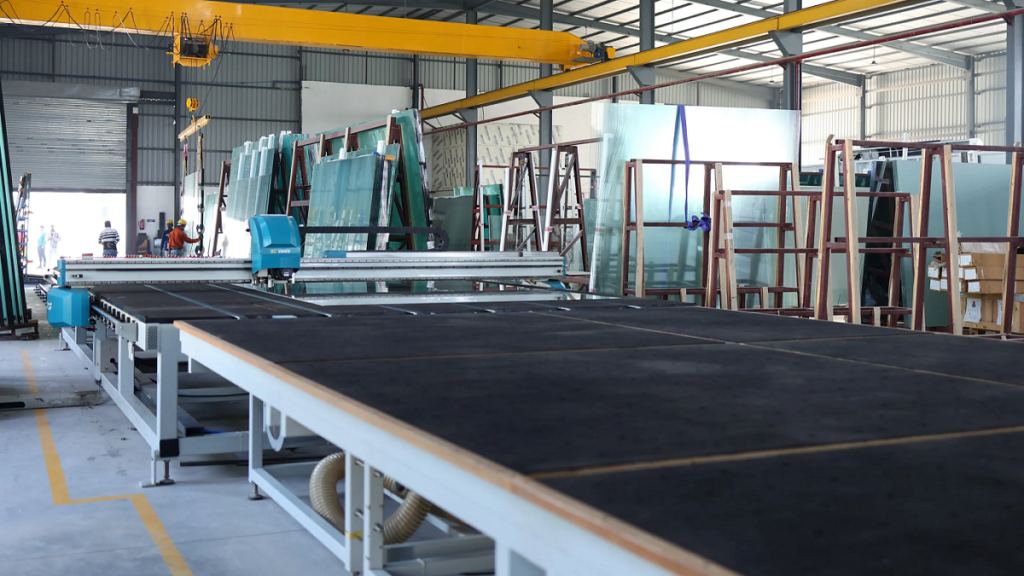Glass is a versatile component in modern architecture that carries various functions beyond just ordinary implementations for doors and windows. Before each glass material is approved for applications in various nuances of architectural designs, it undergoes a meticulous manufacturing process where several quality tests and assessments are conducted. Both designers and architects collaborate to shape unique glass masterpieces to suit different interior styles and decor. The finished blueprint is then produced in glass manufacturing industries. Let’s explore how they shape the aesthetics of living spaces.

The Benefits of Using Glass in Modern Living
- The Versatility of Glass
Glass is a versatile material that can be configured to suit any functional layout. Light control, which happens through reflecting, refracting, and transmitting light, makes glass a vital component of designing spaces and moods. Natural light has always been an extra in interior design, and glass works as the middleman, connecting it to the outside and providing a sense of warmth and life.
- Transparency
Glass is transparent and has reflective properties that welcome natural light and make a room lively and bright. By carefully placing reflective surfaces, designers can effectively control sightlines, generate spatial illusions, and augment the overall visual appeal.
- Transformative Options
Glass can be transformed through various texture and finish options, such as frost, etched, or tinted glass, which introduce visual interest and privacy. Textured glass panels add tactile appeal and diffuse light in captivating patterns, elevating the sensory experience of interiors.
- Integration with Other Materials
Glass mixes in with other materials so well that it creates visually stunning contrasts in interior spaces. Advanced glass technology has revolutionised energy efficiency in interior design, with low-emissivity coatings and insulated glass units minimising heat transfer and reducing reliance on artificial heating and cooling systems.
- Safety and Durability
In terms of glass manufacturing, architectural glasses are made according to all necessary safety measures written in their ISI (Indian Standards Institution) and ISO (International Organization for Standardization) standards. Toughened and laminated glass variants provide extra resistance to bending and breakage, guaranteeing occupants’ safety. The durability and reliability of glass products are ensured through the application of stringent quality control and compliance with regulatory standards.
- Customisation Options
Customisation is a core value of glass manufacturers, who provide custom solutions that match each project’s specific requirements and tastes. They work closely with architects and designers to realise creative ideas so that rooms can be more than just functional and evoke powerful emotions.

How Glasses Are Manufactured
Contemporary buildings rely largely on glass as a construction element. Glass serves not only as a functional component but also adds aesthetic value to all types of structures. Thanks to new technologies and production procedures, glass manufacturing has evolved dramatically from ancient times to the present.
- Getting the Raw Materials Ready
The first step in the production process is the processing of raw materials. Usually, this entails locating premium components like chalk (CaCO3), soda (NaOH), potash (KOH), and pure sand (SiO2). These ingredients are precisely measured and combined to make a homogenous batch prepared for melting.
- Melting Procedure
The combined batch of raw materials is subsequently heated to temperatures exceeding 1000°C in a furnace. The raw components melt and combine inside the furnace to create a combination of molten glass. To guarantee the best possible quality and uniformity, this molten glass is closely watched over and managed.
- Manufacturing into Desired Forms
Once the glass is melted to the required density, it is ready for shaping into different parts. The melted object is normally made using a fabricator, which allows for the shape to be pumped equally into sheets, panels, or other architectural components. Paying close attention to detail is fundamental in this stage since it is used to achieve the shape and the characteristics you want them to have.
- Annealing Process
After being transformed into the desired shape, the glass is annealed to reduce internal stresses and improve its quality. It should be performed in numerous steps, with the glass sheet gradually cooling at a controlled rate at each step to prevent cracking or deformation. Annealing ovens are used to maintain the thermal stability of glass by delivering uniform cooling throughout the block.
- Modern Manufacturing Operations
In modern glass manufacturing facilities, the process is divided into three main operations:
- Batch House: This is the stage where raw materials are handled and prepared for melting. Much care is provided to the mix composition and batch quality to guarantee the same results.
- Hot End: This part encompasses the melting process, furnaces, annealing ovens, and forming machine operations. Here, the raw materials are turned into molten glass and then formed into architectural components.
- Cold End: Once the glass is made and annealed, it moves to the cold zone of the manufacturing process. At this point, it undergoes product inspection and packaging before it is finally shipped to customers.
- Coating and Laminating
Glass coatings and laminations are also used to improve function and appearance. Low-emissivity coatings reduce heat transfer and increase energy efficiency. Meanwhile, tinted films minimise glare and protect against harmful UV rays. Insulated glasses act as sound barriers while enhancing the visual appeal of buildings. Decorative films add visual interest with their texture, while plain glass surfaces are converted into active decorative aspects throughout.
- Decorative Techniques
Specialised decorative techniques add textures, patterns, and colours to the glass surface, enhancing the design and opening up new possibilities. Sandblasting, acid etching, screen printing, and bonding glass with metal or other materials are all techniques used to create intricate designs and captivating visual effects. These techniques elevate glass from a purely practical material to a versatile medium for art.
- Quality Control
The attention paid to detailing, precision, strength, and safety is the essence of the quality control procedures carried out by glass manufacturers. Modern testing technologies evaluate parameters like the glass thickness and the degree of flatness and sharpness, allowing precise performance in every field.
Conclusion
Architectural glass manufacturers such as Glass Guru are at the forefront of addressing environmental concerns in glass manufacturing by incorporating protective glass technology trends into a sustainable strategy. We exercise environmental stewardship by using recycled materials, implementing energy-efficient production techniques, and investing in ecologically responsible disposal strategies. When you have a glass project, whether residential or commercial, consider the Glass Guru for excellent solutions adapted to your needs.
